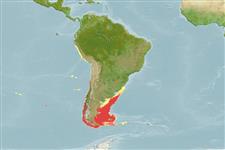Preferred temperature (Ref.
123201): 4.4 - 9.7, mean 6.5 °C (based on 275 cells).
Phylogenetic diversity index (Ref.
82804): PD
50 = 0.5039 [Uniqueness, from 0.5 = low to 2.0 = high].
Bayesian length-weight: a=0.00550 (0.00273 - 0.01106), b=3.10 (2.93 - 3.27), in cm total length, based on LWR estimates for this (Sub)family-body shape (Ref.
93245).
Niveau trophique (Ref.
69278): 3.7 ±0.7 se; based on size and trophs of closest relatives
Résilience (Ref.
120179): Faible, temps minimum de doublement de population : 4,5 à 14 années (Fec assumed to be <100).
Fishing Vulnerability (Ref.
59153): Low to moderate vulnerability (34 of 100).
Nutrients (Ref.
124155): Calcium = 104 [14, 2,653] mg/100g; Iron = 1.3 [0.1, 18.2] mg/100g; Protein = 14.5 [12.8, 16.3] %; Omega3 = 0.786 [0.191, 3.039] g/100g; Selenium = 8.13 [0.98, 53.40] μg/100g; VitaminA = 215 [10, 4,200] μg/100g; Zinc = 1.67 [0.12, 19.86] mg/100g (wet weight); based on
nutrient studies. 